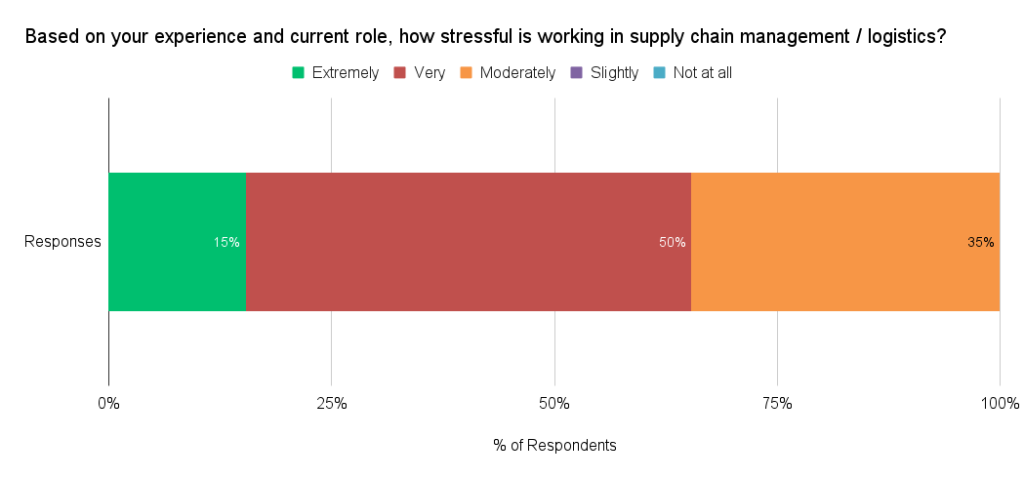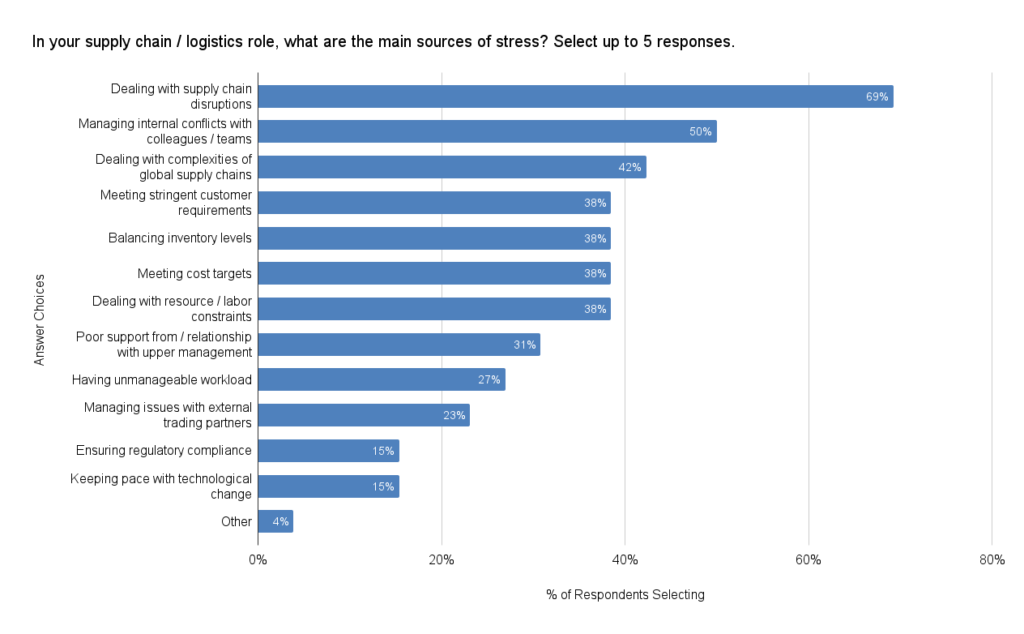As reported by Sky News in September 2023, “The Chartered Institute for Personnel and Development (CIPD) said that analysis of data from over 900 companies employing 6.5 million staff found an average 7.8 absence days per employee over the past year…The report said 76% of respondents had been off work due to stress over the past year, adding that it was also a top cause of longer-term absences.”
How stressful is working in supply chain management? What are the main sources of stress?
We asked members of our Indago supply chain research community — who are all supply chain and logistics professionals from manufacturing, retail, and distribution companies — those questions in a March 2024 survey.
Almost two thirds of our member respondents (65%) said that working in supply chain management / logistics is either “Stressful” (50%) or “Very Stressful” (15%); the remaining 35% said it was “Moderately” stressful.

“Supply chain is extremely stressful,” said one supply chain executive. “The last 4 years completely changed what it means to be a supply chain professional.”
Another executive commented:
“‘The supply chain eats its young’ is a common adage in the community. The space is highly nuanced and variable to degrees not seen in other parts of a business. Because of this, most executives don’t understand the vital role the supply chain plays for their business, and they care little for the needs of it. So, to say life in the supply chain is stressful is an understatement. It requires the type of person who enjoys never ending challenges and dealing with complex problems.”
In terms of the main sources of stress, “Dealing with supply chain disruptions” topped the list, with 69% of the respondents selecting it. This was followed by “Managing internal conflicts with colleagues/teams” (50%) and “Dealing with the complexities of global supply chains” (42%).

“Obviously, 2020 was the worst disruption our industry (industrial distribution) has seen in my career (19 years),” shared one of the executives. “But even now we still have some products that used to be 8-12 weeks pre-Covid that are running 60+ weeks for lead times. This causes additional stress with contract reviews and meeting strict delivery times, and then even more stress when our suppliers miss those dates.”
Here are some other value-added comments submitted by Indago member executives:
“When multiple stress factors converge is when the stress levels really climb. I frequently experience stress when disruptions converge with resource constraints (i.e.: a supplier fails to produce or deliver, and that situation is exacerbated by limited storage capacity and limited safety stock to cover such a disruption.)”
“Stress is higher today in my opinion. Since supply chain staff cannot directly control most of the information and materials that they have to manage, stress is higher after the pandemic and the VUCA [Volatility, Uncertainty, Complexity, Ambiguity] business environment it provoked.”
“The level of stress has remained high since 2020 Covid times, where we have had a lot of supply chain pressures due to disruptions with the added need to strategically review entire supply chain operations, end to end, given cost pressures.”
“The stress level seems to be an ‘always on’ situation for several years now. The level of supply chain scrutiny remains high even after we have gotten out of what appears to be the worst of the current disruptions. We are constantly waiting for the other shoe to drop.”
What strategies do these supply chain executives use to prevent burnout and maintain mental health? For insights on that question and more, download the report.
What do you think? Is the stress level in supply chain management higher today than in the past? What strategies do you use to prevent burnout and maintain mental health? Post a comment and share your perspective!
Join Indago Today!
If you’re a supply chain or logistics practitioner from a manufacturing, retail, or distribution company — and you’re interested in learning from your peers — I encourage you to learn more about Indago and join our research community. It is confidential, there is no cost to join and the time commitment is minimal (2-4 minutes per week) — plus your participation will help support charitable causes like Breakthrough T1D (formerly JDRF), American Logistics Aid Network, American Cancer Society, Feeding America, and Make-A-Wish.










